Types of Innovation – The Ultimate Guide with Definitions and Examples
Innovation can be a confusing topic because there are so many different kinds of innovations out there and everyone seems to use the term differently.
Although you often hear about innovation in terms of technology and although it’s true that technological innovation has been, and will likely continue to be, the most obvious form of innovation, it comes in variety of other forms too.
Most innovations are smaller, gradual improvements on existing products, processes and services while some innovations can be those ground-breaking technological inventions or business models that transform industries.
Because the environment and the needs of your customers are constantly changing, you need to be able to improve different areas of your business to solve emerging problems and to keep creating new value for your customers.
Thus, knowing what types of innovations there are for an organization to pursue can help you discover the ones that are most suitable for your business. Understanding and focusing on the most potential ones not only helps you respond to these changing needs but also allows you to improve your ability to grow the business.
In this post, we’ve decided to approach the topic by first presenting the most common ways to classify innovation, and then providing you with a few simple tips on how to get started in managing them within your organization.
Innovation Taxonomy
Innovation can be categorized in many ways, and some of those categorizations are more or less overlapping. The purpose of this post is to help you understand different approaches to innovation and how different types of innovations link to the big picture.
Innovation Matrix
One way to categorize innovation is to classify it based on two dimensions: the technology it uses and the market it operates in. We can use the innovation matrix to visualize the most common types of innovation:
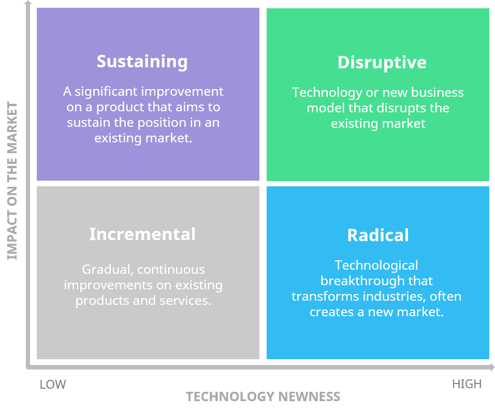
Incremental innovation
Most innovations are incremental, gradual and continuous improvements in the existing concepts, products or services in the existing market.
Incremental innovations are just a little better than the previous version of the product or service and has only slight variations on an existing product formulation or service delivery method.
Products can be made smaller, easier to use or more attractive without changing the core functionality of it and services can be made more efficient through constant improvement.
Although incremental innovation does not create new markets and often does not leverage radically new technology, it can attract higher paying customers because it fulfils the customer needs identified from their behaviour or feedback.
The product or service may also appeal to a larger, mainstream market if you’re capable of providing the same functionalities and value at a lower cost.
TV is a classic example of both of these scenarios as it’s constantly improved and there are new models available while the core idea and the components remain mostly the same. The mainstream customer can, for example, have a 50” LED television with just a couple of hundred dollars while the more demanding customers can easily spend thousands on a 75” OLED TV.
What’s convenient about incremental innovation is that it’s often easy to sell because you don’t need to explain the key principles of your product or service – people are already familiar with the way it works.
A possible downside is that incremental innovations do not necessarily make a huge impact because they’re often just slightly better than what’s already out there.
There’s also a risk of over-complicating products and adding too many features no one wants to pay for. Thus, you shouldn’t ignore the customers who just want a simple, low-cost alternative of your product unless you specifically choose to target the more demanding customer segment and to provide them with premium products.
Another risk related to incremental innovation is that the market may (and will) change at some point because of disruption. If that is the case, relying on just incremental innovation isn’t going to be enough to keep up with the changes.
Thus, it’s important to focus on simultaneously improving the core business while also looking for new ways to create value by searching for new business models and working on disruptive innovations.
Disruptive innovation
Disruptive innovation is a concept introduced by professor, academic and business consultant Clayton Christensen first in an HBR article and later in his book called Innovator’s Dilemma.
Disruptive innovation is a theory that refers to a concept, product, or a service that creates a new value network either by entering an existing market or by creating a completely new market.In the beginning, disruptive innovations have lower performance when measured by traditional value metrics but has different aspects that are valued by a small segment of the market. These types of innovations are often capable of turning non-customers into customers but do not necessarily appeal to the needs and preferences of the mainstream customers, at least not just yet.
What makes disruptive innovation difficult, is that established organizations are completely rational when making decisions related to their existing business. They fail to adjust to the new competition because they’re too focused on optimizing the existing offering or business model that has proven to be successful in the market so far.
Thus, the market is generally disrupted by a new entrant rather than an incumbent.
This phenomenon called Innovator’s Dilemma is actually quite logical because the existing market is often bigger, and the margins are better.
Disruptive innovation is where traditional business methods fail and requires new capabilities. Although the risks are big, there’s a huge growth potential if everything goes right.
Once the incumbents realize that new disruptive innovations are used by the mainstream, it is often too late for them to catch up despite the amount of resources they have at their disposal.
At this point, new entrants are already delivering an alternative solution that require new capabilities the traditional companies don’t necessarily have, eventually adding things that the mainstream customers want.
Tesla, for example has different capabilities compared to the more traditional car manufacturers. Its software, battery technology and the ability to iterate quickly are capabilities that traditional car manufacturers aren’t very good at, and which will take time and resources for them to acquire.
Another example of disruptive innovation is Netflix, whose initial mail-in movie subscription service wasn’t attractive to Blockbuster’s mainstream customers, but rather to those early adopters who were already used to online shopping.

However, Netflix did not reach the mainstream until after disrupting itself from its DVD mail service to web streaming. Now there are tons of online movie subscription services available for customers to choose from and this model has slowly become a norm, gradually transforming the industry.
Despite the connotation, disruption doesn’t usually happen abruptly. The SaaS business model, for example, wasn’t very successful when it was first introduced in the beginning of 2000 but has gradually become the standard in the past 20 years.
To avoid being disrupted, you want to keep an eye on the new entrants in your market and how they do things. Typically, disruption always strives to strike at superfluous margins. For example, digitalization strikes hard at all the middlemen and these companies and professions will mostly disappear in the coming years.
So, instead of just relying on your past success in serving the most profitable customer segment, you should also work on business model innovation to discover new profit centres that may not necessarily seem as appealing just yet but may have a significant growth potential in the near future.
Sustaining innovation
Sustaining innovation is the opposite of disruptive innovation as it exists in the current market and instead of creating new value networks, it improves and grows the existing ones by satisfying the needs of a customer.
Just like incremental innovation, the product performance of sustaining innovation is made slightly better with every iteration, reducing defects. The new improved version of the product can be more expensive and have higher margins than the previous one if it targets more demanding, high-end customers with better performance than what was previously available.
However, it might as well be cheaper if it leads to higher volumes and thus higher absolute profits.
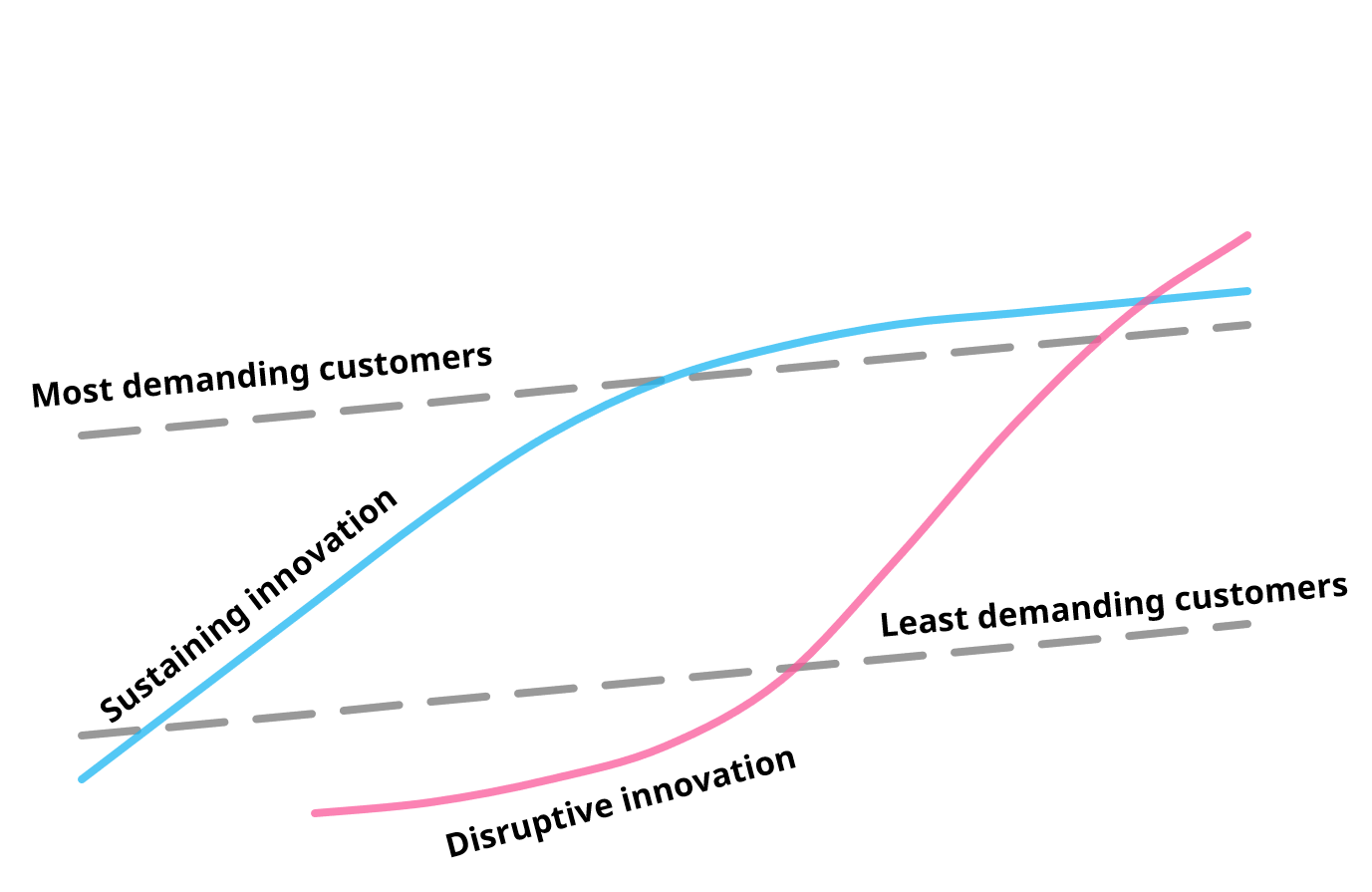 Traditional business methods and sustainable innovations are often sufficient because they are the most profitable, and the risks are lower. Disruptions, on the other hand, typically enable top-line growth: large market share growth or the creation of an entirely new market but aren’t typically profitable for a long time because it makes sense for disruptors to invest heavily in growth.
Traditional business methods and sustainable innovations are often sufficient because they are the most profitable, and the risks are lower. Disruptions, on the other hand, typically enable top-line growth: large market share growth or the creation of an entirely new market but aren’t typically profitable for a long time because it makes sense for disruptors to invest heavily in growth.
Sustaining innovations, in turn, continue to grow the market slowly, but no longer in the same proportion. At this point, the focus shifts to increasing profits.
An example of a once disruptive, currently fully sustaining and profitable innovation is iPhone, where the recent versions of the phone appeal to the same customer segments and do not create new value networks. As the criticism of lack of innovativeness of the new iPhone has increased, the firm’s profits have grown at the same pace.
New models of the phone sustain the existing business model in the premium segment of the market to meet the needs of a more demanding customers who are willing to pay more for a newer, slightly better version of the phone.
”Some sustaining innovations are the incremental year-by-year improvements that all good companies grind out. Other sustaining innovations are breakthrough, leapfrog-beyond-the-competition products. It doesn’t matter how technologically difficult the innovation is, however: The established competitors almost always win the battles of sustaining technology.
Because this strategy entails making a better product that they can sell for higher profit margins to their best customers, the established competitors have powerful motivations to fight sustaining battles. And they have the resources to win.”– Clayton Christensen
Radical innovation
Radical innovation is rare as it has similar characteristics to disruptive innovation but is different in a way that it simultaneously uses revolutionary technology and a new business model.
Radical innovation solves global problems and addresses needs in completely new ways than what we’re used to and even provides solutions to needs and problems we didn’t know we had, completely transforming the market, or even the entire economy.
Although radical innovations are rare, there have been more and more of them in the recent past.
Technological innovations, such as personal computer and the internet are examples of radical innovations that have transformed the way the entire world functions and communicates. These disruptive innovations provide our society with a platform to build on top of, leading to highly accelerated economic growth.
According to ARK Invest, an investment management company, there’s a new, even bigger wave of radical innovations that they consider to be on the verge of the becoming mainstream. These are robotics, artificial intelligence (AI), blockchain technology, energy storage and genome sequencing.
Source: ARK Invest, used with permission.
Because radical innovation is so different from what people are used to, it does usually face significant resistance at first. These types of innovation typically require a lot of time and technological development before they’re ready for the mainstream markets.
However, when executed successfully, it often means the beginning of a new era that affects many sectors and geographies.
Other Types of Innovation
While the aforementioned four types of innovation in the innovation matrix are a common way of describing the technology an innovation uses and the impact it has on the market, it’s not the only way to categorize innovation.
You wouldn’t necessarily start your next innovation initiative by just telling people to come up with new disruptive business ideas that are going to transform the entire industry, or simply to make more incremental innovation happen.
To get more concrete and actionable results, innovation should be approached holistically. In this part of the post, we’ll introduce other types of innovation that can be used to improve and unlock new value in different parts of your business.
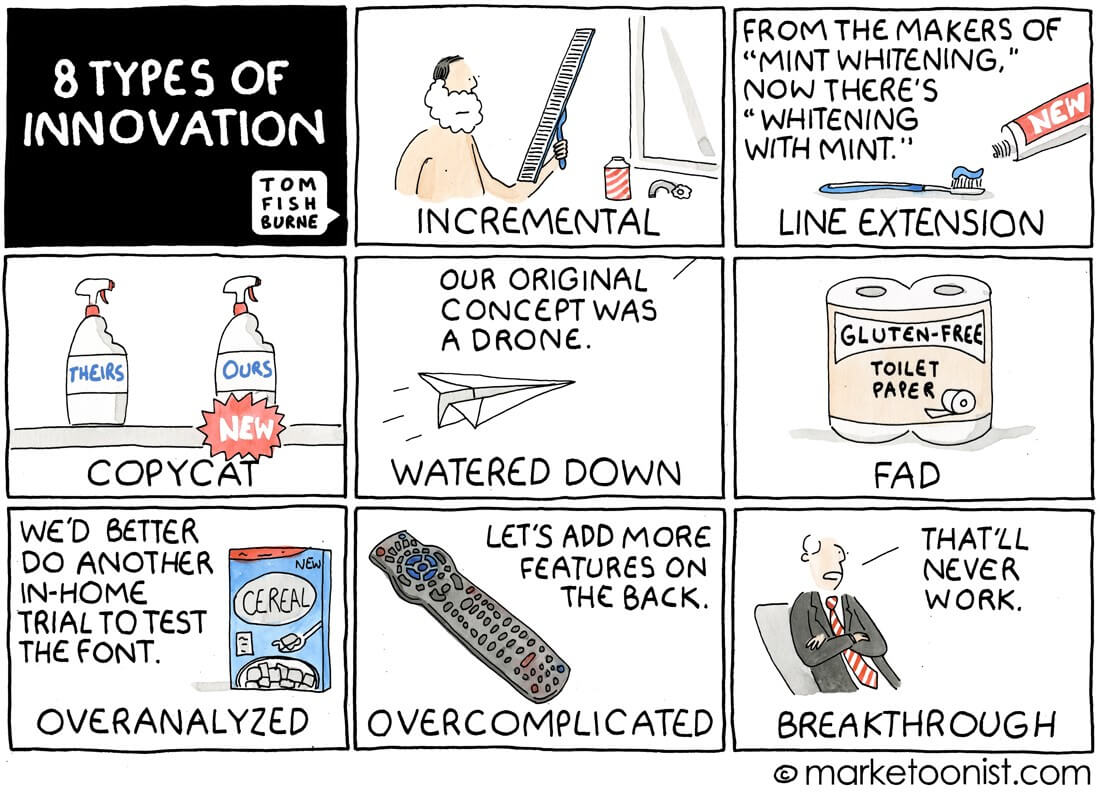
Ten Types of Innovation
Doblin’s Ten Types of Innovation is a model that can be used to revisit existing strategies to develop viable innovations across all levels of your organization.
This framework can be used as a diagnostic tool to assess how innovation should be approached internally and to evaluate which aspects to improve on that aren’t solely focused on technology innovation.
This kind of holistic approach can help you analyze your competitive environment and reveal gaps and potential opportunities for incremental improvement as well as doing something completely unique.
Compared with the innovations mentioned above, the Ten Types of Innovation Framework approaches innovation from a more practical point of view.
The Ten Types of Innovations model claims that all great innovations throughout the history are comprised of some combination of the following categories of innovations:
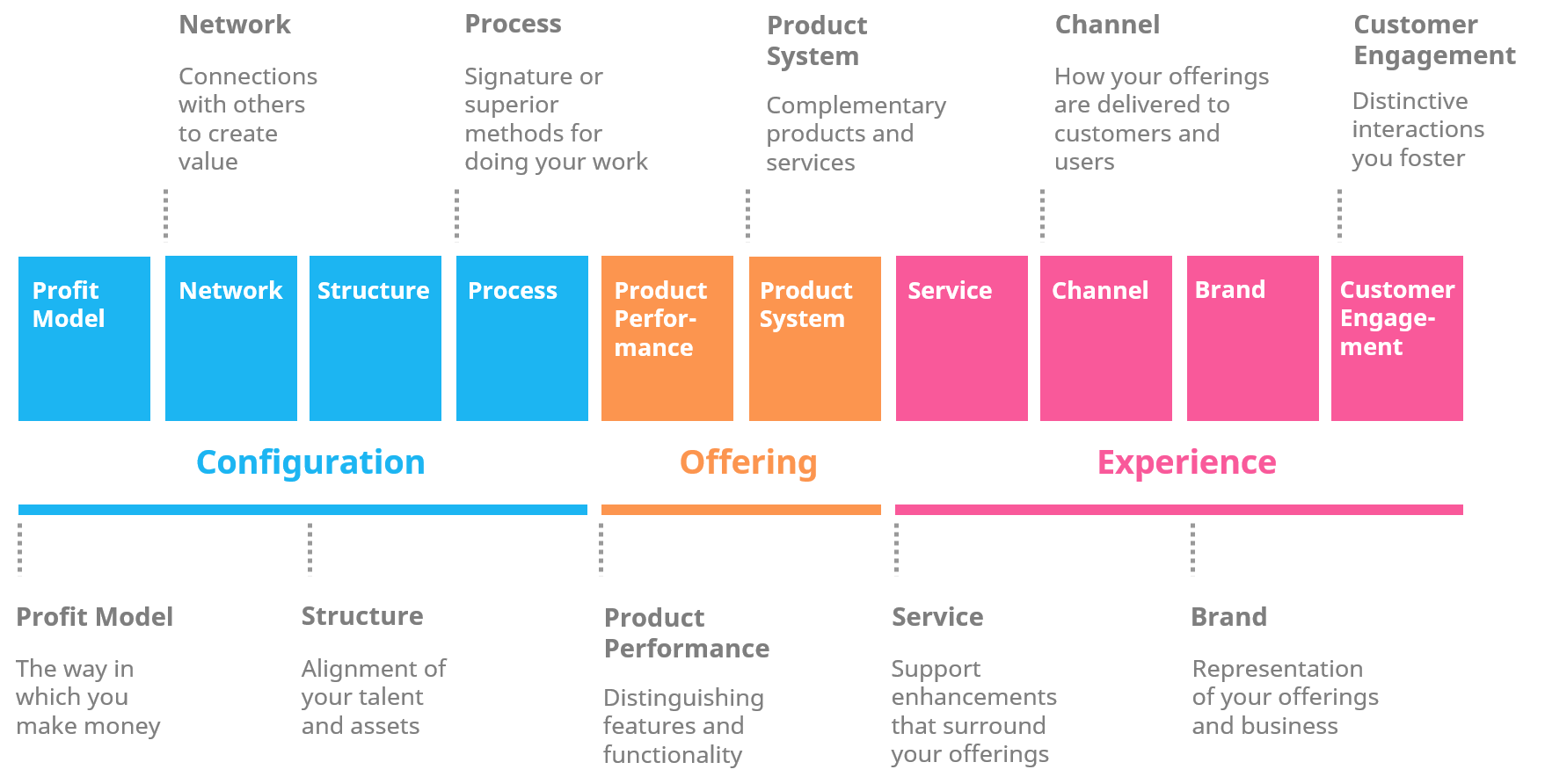 In the Ten Types of Innovation framework, the different types of innovations are divided into three main categories: configuration, offering and experience. In layman’s terms, business model, product and marketing.
In the Ten Types of Innovation framework, the different types of innovations are divided into three main categories: configuration, offering and experience. In layman’s terms, business model, product and marketing.
The types on the left side of the framework are the most internally focused and distant from customers. As you move toward the right side, the types become increasingly apparent and obvious to end users.
Although it may not be realistic to start working on all of these areas at once, especially if you are new to innovation, you can use this framework to analyze your current state and the existing competition to spot areas that need immediate attention, are missing completely, or could become competitive advantages for your innovation.
Once you get more experienced with innovation, you’d ideally want to focus on making continuous improvements in all, or at least most, of these areas.
Product innovation
Product innovation is probably the most common form of innovation and it refers to improvements in performance characteristics and attributes of the product. It can also use components that differ from previously manufactured products.
Product innovations are always tangible, can involve radically new technologies or can be built based on combining existing technologies in a new way, although they don’t necessarily have to involve any technology at all.
 A product innovation can be a completely new product that has never been seen before, such as the fidget spinner, or it can be an improved version of an existing product, such as wireless headphones or the 2nd generation Amazon Echo. It can also be a new feature to an existing product, such as a dynamic turn indicator in a car or foot massaging shoe insoles that leverage magnetic technology.
A product innovation can be a completely new product that has never been seen before, such as the fidget spinner, or it can be an improved version of an existing product, such as wireless headphones or the 2nd generation Amazon Echo. It can also be a new feature to an existing product, such as a dynamic turn indicator in a car or foot massaging shoe insoles that leverage magnetic technology.
There are some evident drivers of product innovation, such as changes in customer requirements, need to increase the life cycle of the product, urge to tap new markets or segments, or simply to enhance the look-and-feel and the convenience of using the product.
Product innovation is a great way to improve quality and product reliability to either gain competitive edge or sustain your position in the market. In addition, it can help reduce processing and manufacturing costs.
Service innovation
Service innovation refers to a new or significantly improved service concept, product or process in a new or existing market. It can be for example a new customer interaction or distribution channel, a system that improves the delivery process or new solutions in the customer interface.
The way you serve your customers is a great way to differentiate, generate more value for them and deliver more revenue for your organization. A big part of a successful business is the ability to make your customers lives easier and the better you’re able to meet the needs and expectations of the ones you serve, the brighter your future looks like. Uber is an example of a service innovation company that has created further growth outside its core business. With UberEATS, it has used its strengths and unique capabilities, such as its brand to enter into adjacent markets. The fact that they’re already in peoples’ phones and that they’re already organizing transportation has helped them to extend their line of offerings and provide their customers with new value.
Uber is an example of a service innovation company that has created further growth outside its core business. With UberEATS, it has used its strengths and unique capabilities, such as its brand to enter into adjacent markets. The fact that they’re already in peoples’ phones and that they’re already organizing transportation has helped them to extend their line of offerings and provide their customers with new value.
Process innovation
A process combines the skills, technologies and structures that are used to produce products or provide services.
Process innovation generally refers to the implementation of a new or significantly improved production or delivery method. It may also be indirectly related to the company’s products and services, for example in the form of support function processes in HR or finance.
Process innovation can be done by applying new technology or improved method to a process and is often done to save time, money, or to serve customers better. It often involves new techniques, equipment, or software, and can often require a cultural or structural change as well. In process innovation, the final product is usually not changed, but the method of bringing out the product is improved.
In process innovation, the final product is usually not changed, but the method of bringing out the product is improved.
An example of a process innovation is automated replenishment ordering for retail stores. Previously, an employee had to manually go through all the products one by one to see how much should be ordered. This is not only extremely time consuming but easily leads to over- or under-stocking, depending on whether the estimate is conservative or not.
A more modern way is to use statistical models to calculate a significantly more accurate forecast. If automated orders are created by a system, you can simply let staff double check the pre-calculated order proposals, for example in case the order happens to exceed a certain threshold value. This can not only save you a lot of time and money but having better stock levels also improves your ability to serve customers.
Technological innovation
Technology as a source of innovation can be identified as a critical success factor for increased market competitiveness.
Technological innovation involves new or improved technology, such as new type of machinery or alteration of some form of technology into a product, processes or service delivery methods.
When talking about incorporating technology into a production process, for example, it enables automation which results in higher production rates, lower cost per unit of output, and enables more efficient use of materials – reducing variability and resulting in more consistent product quality.

We’re using a number of technological product innovations daily all the way from our smartphones and health devices to wireless home sound systems. SONOS, for example, has created advanced technology to provide a wireless multi-room music experience. They initially meant to choose Linux as the technology platform, but no audio drivers existed at the time, so they had to build it themselves.
When it comes to technological service innovation, McDonald’s has taken a holistic approach to the digital to create engaging customer experiences. Their main strategic objective has been to use technology to improve the in-restaurant experience and to create the next generation of drive-throughs and delivery.
They’ve already said goodbye to cashiers and replaced them with self-ordering kiosks. They also provide you with an application you can use to order and pay for your meal before picking it up to avoid the line.
Business model innovation
In all its simplicity, the business model is how a company functions and earns money. It consists of core values and resources, strategy, core channels and target customers, to name a few.
Business model innovation is a fundamental change in how a company delivers value to its customers or captures it from the market. In practice, it often happens through the development of new pricing mechanisms, revenue streams or distribution channels but isn’t limited to them.
What’s challenging about business model innovation is that the capabilities and processes that have been optimized to make a company successful, become the targets for transformation. To be able to create new, viable business models, you usually need to change the fundamental decisions upon which your business operates. In other words, to work on disruptive innovations.
Business model innovation often means higher risks for a company in the short term but is critical to long-term survival and for not being disrupted. On the other hand, business model innovation and especially digital services, may have higher operating margin growth, so these types of innovations can really be worth pursuing.
Purchasing music, for example, has transformed twice in the past couple of decades. iTunes is an interesting example of disaggregation model – a strategy that breaks down or separates something into constituent parts or elements. Before iTunes started to sell single tracks, you either had to buy the entire album to hear your favourite song or sit by the radio at the right time to be able to record it.
Later, Spotify took the digital music business to a completely different direction with its freemium streaming model by cutting out the middleman and dealing with customers directly online.
Some industries, such as manufacturing, financial services, logistics, and healthcare are more likely to be affected by the upcoming wave of disruption than others. However, no industry will be completely safe.
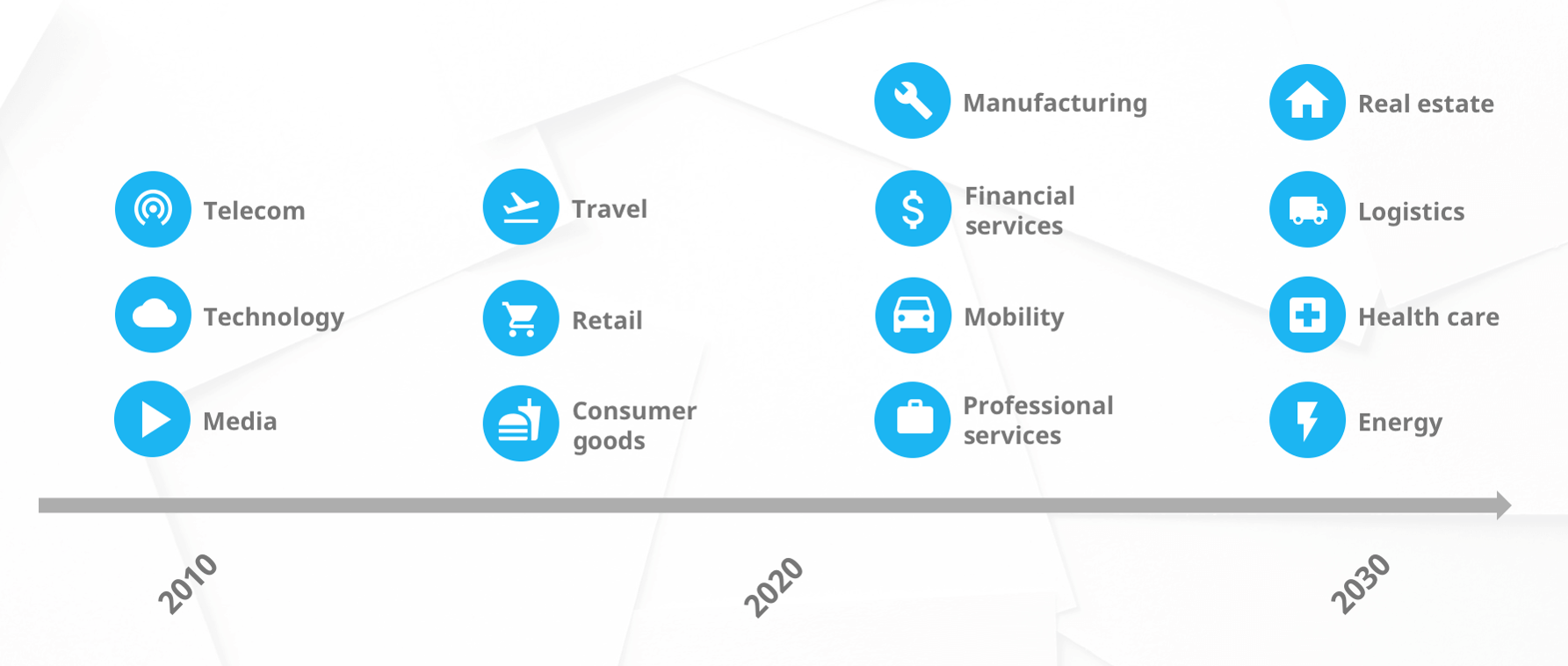
If you’re uncertain whether to focus on business model innovation or not, look for signs that indicate that your business is at risk of being disrupted:
- Saturated market
- Outdated technology
- Undesirable change in industry margins
- Unwillingness or inability to keep up with global trends
- Low customer satisfaction
If you’re experiencing more than one of these signs, it’s definitely time start innovating around your business model and value promise and think of new ways to make revenue.
Marketing innovation
For an innovation to be successful, people need to be able to find it and then benefit from it. The main purpose of a marketing innovation is to open up new markets or increase market share.
An innovation is typically considered to be a marketing innovation if it brings significant changes to the “traditional” marketing mix (4Ps: Price, Product, Promotion and Place) of the industry in question.
The ability to connect with your customers is key and there is always room to improve relationships and customer engagement. Because of the constantly evolving technology and customer preferences, new marketing innovations are needed to promote both new and existing products and services.
Coming up with innovative marketing practices enables you to enhance those customer relationships in ways they might not even expect. L’Oréal cosmetics company, for example, has developed its Makeup Genius App to reach a wider customer group and to elevate their engagement with the brand.
Using such innovative technologies in their marketing also has the added benefit of allowing them to enhance the online shopping experience by using data to suggest products that match the personal preferences of the customer.
Although technology plays an important role in future marketing innovations, it doesn’t necessarily always have to leverage new technology.
Marketing innovations are different compared to other innovations in the sense that they can also be used to promote existing products or services in a different way than what has been done previously. For example, a product initially used for one purpose can be promoted for another purpose.
Ski poles, for example, have been used by skiers and trekkers for decades to provide them with balance and support in challenging conditions. Now Nordic walking has become a popular sport activity that started from using ski poles marketed for off-season-ski-training as a clever way to increase energy consumption from regular walking.
Architectural innovation
Architectural innovation is a concept introduced by a Harvard Business School professor Rebecca Henderson and dean Kim Clark back in 1990.
Architectural innovation is described as the reconfiguration of existing product technologies that creates an improvement in the ways in which components, some of which are not necessarily innovative together, are combined.
 Some examples of architectural innovations include networked computer systems and flexible manufacturing systems, where the core components of the product remain the same, but the relationship between these components and how they link to one another, changes.
Some examples of architectural innovations include networked computer systems and flexible manufacturing systems, where the core components of the product remain the same, but the relationship between these components and how they link to one another, changes.
From a technical point of view, architectural innovations are often less risky compared to other types of innovations because the technology has already been proven to work. Thus, there’s no need to spend time and money on testing how these technological components work in practice – you just need to make sure they work together.
However, the market risk still exists, which is why it’s important to make sure your product or service has clear demand.
Social innovation
Social innovations are new practices or technological inventions that aim to meet social needs in a better way than the existing solutions. These types of innovative solutions can be provided or funded either by public or commercial entities.
There are many reasons why social innovations are important, such as to improve working conditions, provide more education, develop the community or make the population healthier. Thus, it can be said that social innovations are necessary for extending and strengthening civil society.
Clean water technologies and innovations, such as potable water generators that capture air humidity and turn it into drinking water, are examples of social innovations that can help alleviate the issue of uneven distribution of clean drinking water now and in the future.
A Finnish start-up called Gubbe.io has successfully combined technological service innovation and social innovation by providing a platform that connects students to seniors who need help with housework, technology, transportation, or simply staying active.
Embracing social innovation is not just about doing good for society but also about doing good business. We wrote more in detail about social innovation and the businesses benefits organizations can leverage.
What is next?
Innovation can be categorized in many ways and the point of these classifications is to deepen your understanding of what types of opportunities there are and how different types of innovations can work in your business context.
The most ambitious innovators find the right mix of the ones above and apply them as extensively as possible within their organizations. Instead of relying on a single R&D process, or a single type of innovation, they use and manage different types of innovations holistically and systematically.
 Whether you’re just about to get started with innovation, have already gained some successful experience from it, or are a battle-scarred veteran innovator, you can still try to find new growth opportunities in your organization, no matter your current level.
Whether you’re just about to get started with innovation, have already gained some successful experience from it, or are a battle-scarred veteran innovator, you can still try to find new growth opportunities in your organization, no matter your current level.
Your approach to innovation depends mainly on your unique capabilities and strategic goals. Ultimately, managing innovation is no different than managing any other major change, and more or less the same principles apply.
Although it's important to move fast, don't bite off more than you can chew.
To avoid unnecessary havoc, you want to go through different aspects of your business and to:
- Assess your current state
- Prioritize the areas that need improvement
- Break down your strategic goals into smaller, easily implemented pieces
- Commit to the process
If, for example, your strategic priority is to improve the efficiency of your operations, you could get started by monitoring and analyzing the existing processes.
Once you have detected and prioritized the most critical areas for improvement, let’s say, the information flow, you’d then create an actionable plan for removing any obstacles that might be standing in the way of information exchange.
This may mean making changes to the organizational structure or implementing new technology that helps improve coordination and communication between different business and support functions.
Conclusion
Reading this post is just the first step towards understanding and capitalizing the endless opportunities you have with innovation.
Although some organizations want to focus on cool disruptive technologies and transformational business models, even the most radical innovations result from continuous small improvements. So, you can still make an impact even if you only focus on improving your core business.
If you’re already further ahead in your innovation journey, keep investing in growth and driving repeatable innovation practices across your company.
We've also created a downloadable version of this post. You can now download The Ultimate Guide to Different Types of Innovations by clicking below.








